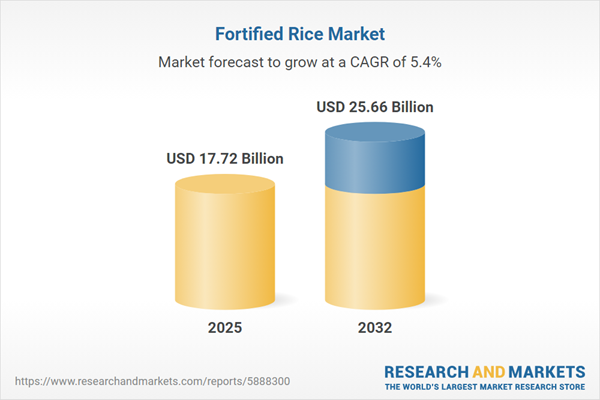Speak directly to the analyst to clarify any post sales queries you may have.
The fortified rice market continually adapts to shifting regulations, technological progress, and evolving consumer preferences. Senior decision-makers are positioned to leverage these changes by closely tracking industry trends and aligning strategies with both policy and operational realities.
Fortified Rice Market Snapshot
Global demand for fortified rice is accelerating as government micronutrient supplementation policies gain momentum and industry participants invest in innovation. The market achieved USD 16.82 billion in 2024, is expected to reach USD 17.72 billion in 2025, and is forecast at USD 25.66 billion by 2032, with a projected CAGR of 5.42%. Momentum stems from robust policies to combat malnutrition, advances in extrusion and coating technologies, and greater integration within both retail channels and public health initiatives. As holistic nutrition grows in priority for consumers, manufacturers are advancing resilient product lines that target micronutrient needs, ensure brand differentiation, and strengthen response to supply chain uncertainties.
Scope & Segmentation: Comprehensive Market Coverage
- Form: Coated and extruded rice variants are formulated with adaptable micronutrient blends for multiple consumer groups, serving both mass-market and institutional demands.
- Product Type: Instant rice meets urban convenience requirements, while parboiled versions support traditional consumption patterns and bulk supply to institutions.
- Distribution Channel: Supermarkets, hypermarkets, and specialty outlets improve product reach; convenience stores cater to quick-purchase needs. Online sales and foodservice providers extend educational access and branding opportunities.
- Application: Households, schools, wellness centers, and healthcare facilities increasingly integrate fortified rice to support scalable nutrition programs and improve health outcomes.
- Fortificant: Iron, folic acid, vitamin A, and zinc enhance compliance with diverse nutritional regulations, supporting policy objectives across varied markets.
- Regional Coverage: Market dynamics span North America, Latin America, Europe, Middle East, Africa, and Asia-Pacific. This scope emphasizes regulatory influence in the United States, significant uptake in Brazil and India, and deep integration with China’s public health efforts.
- Company Coverage: Industry leaders such as Koninklijke DSM N.V., BASF SE, Cargill, Olam International, Bunge Limited, ADM, Louis Dreyfus Company, Evonik Industries, Ingredion, and Kerry Group maintain prominence through innovation and geographic expansion.
Key Takeaways for Senior Decision-Makers
- Fortified rice aligns with multi-sector health initiatives and plays a critical role in addressing micronutrient deficiencies at scale.
- Technological advances in extrusion support precise multi-nutrient blending, driving improved product consistency and manufacturing efficiencies.
- Supply chain transparency and clean-label requirements are prompting new supplier collaborations and increased focus on sustainability, affecting procurement choices and brand positioning.
- Strategic relationships across suppliers, millers, and distributors are streamlining the value chain, delivering higher standards for quality, compliance, and delivery.
- Institutional nutrition programs continue to drive category adoption, while urbanization and shifting lifestyle patterns increase demand for quick-preparation fortified rice products.
Tariff Impact: Navigating Global Trade Shifts
Recent changes in U.S. tariff structures have prompted fortified rice manufacturers to reassess sourcing and production planning. In response, firms are building stronger domestic processing capacity and closer partnerships with local suppliers, which ensures continued production and limits short-term disruptions linked to tariff changes. Developing flexible supply chains and resilient procurement networks has become central for cost management and stable delivery amid evolving trade landscapes.
Methodology & Data Sources
This analysis uses structured research methods, combining government policy review, evaluation of industry documents, and interviews with key stakeholders. Peer validation and scenario analysis confirm the findings, supporting informed decisions for B2B leaders active in the fortified rice segment.
Why This Report Matters
- Enables targeted strategic and operational planning by mapping prevailing trends, highlighting technology adoption, and identifying priority action areas for senior executives in the fortified rice sector.
- Provides actionable perspectives on geographical and segment-specific market drivers to support competitive positioning, market entry, and resilient, long-term growth strategies.
- Equips leadership teams to anticipate regulatory and supply chain developments, enhancing the alignment of fortified rice investments with shifting policy and consumer expectations.
Conclusion
Fortified rice connects regulatory advancement, industry innovation, and public health priorities. Senior stakeholders can use these insights to navigate complexity, build resilience, and strengthen their organization’s contribution to improved nutrition outcomes worldwide.
Additional Product Information:
- Purchase of this report includes 1 year online access with quarterly updates.
- This report can be updated on request. Please contact our Customer Experience team using the Ask a Question widget on our website.
Table of Contents
3. Executive Summary
4. Market Overview
7. Cumulative Impact of Artificial Intelligence 2025
Samples

LOADING...
Companies Mentioned
The key companies profiled in this Fortified Rice market report include:- Koninklijke DSM N.V.
- BASF SE
- Cargill, Incorporated
- Olam International Limited
- Bunge Limited
- Archer-Daniels-Midland Company
- Louis Dreyfus Company B.V.
- Evonik Industries AG
- Ingredion Incorporated
- Kerry Group plc
Table Information
| Report Attribute | Details |
|---|---|
| No. of Pages | 195 |
| Published | October 2025 |
| Forecast Period | 2025 - 2032 |
| Estimated Market Value ( USD | $ 17.72 Billion |
| Forecasted Market Value ( USD | $ 25.66 Billion |
| Compound Annual Growth Rate | 5.4% |
| Regions Covered | Global |
| No. of Companies Mentioned | 11 |









